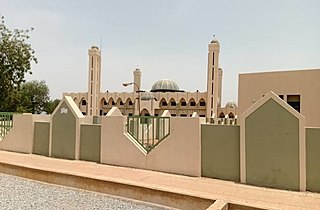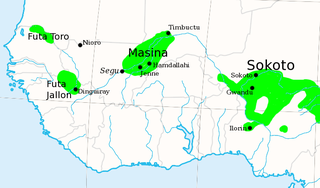Shehu Usman dan Fodio. was a Fulani scholar, Islamic religious teacher, poet, revolutionary and a philosopher who founded the Sokoto Caliphate and ruled as its first caliph.

Sokoto is a major city located in extreme north-western Nigeria, near the confluence of the Sokoto River and the Rima River. As of 2006, it has a population of over 427,760. Sokoto is the modern-day capital of Sokoto State and was previously the capital of the north-western l states. Modern Sokoto is known for trading sheepskins, cattle hides, leather crafts, kola nuts and goatskins.

The Jihad of Usman dan Fodio was a religio-military conflict in present-day Nigeria and Cameroon. The war began when Usman dan Fodio, a prominent Islamic scholar and teacher, was exiled from Gobir by King Yunfa, one of his former students.

The Sokoto Caliphate, also known as the Sultanate of Sokoto, was a Sunni Muslim caliphate in West Africa. It was founded by Usman dan Fodio in 1804 during the Fulani jihads after defeating the Hausa Kingdoms in the Fulani War. The boundaries of the caliphate are part of present-day Cameroon, Burkina Faso, Niger, and Nigeria. By 1837, the Sokoto state had a population of around 10-20 million people, becoming the most populous empire in West Africa. It was dissolved when the British, French, and Germans conquered the area in 1903 and annexed it into the newly established Northern Nigeria Protectorate, Senegambia and Niger and Kamerun respectively.

The Argungu Fishing Festival or Argungu Dance Festival is an annual four-day festival in Kebbi State and other northern states like Niger in the north-western part of Northern Nigeria. The region is made up of fertile river areas of (matanfada, mala with much irrigation and orchards. The majority of inhabitants are fishermen who are practitioners of Isla religion. They also have Kanta Museum. The Museum is the main historical centre in Argungu for visitors across the globe. People from around the world travel to Argungu just to witness the occasion. The main purpose of the Argungu fishing festival is for fishing and unity. The festival is usually a 4-days cultural event.

Kebbi is a state in northwestern Nigeria. Kebbi State is bordered east and north of Sokoto and Zamfara states, and to the south by Niger state while its western border forms part of the national borders with Benin Republic for 103 km and Niger for 207 km. Named for the city of Birnin Kebbi—the state's capital and largest city, Kebbi state was formed from Sokoto state on 27 August 1991. Of the 36 states of Nigeria, Kebbi is the tenth largest in area and 18th most populous, with an estimated population of about 4.4 million as of 2016. The state is known as land of equity.

Sokoto is one of the 36 states of Nigeria, located in the extreme northwest of the country. It is bounded by Republic of the Niger to the north and west for 363 km, and the states of Zamfara to the east, and Kebbi to the south and west, partly across the Ka River. Its capital and largest city is the city of Sokoto. Sokoto is located near to the confluence of the Sokoto River and the Rima River. As of 2022 it has an estimated population of more than 6.3 million.

Northern Nigeria was an autonomous division within Nigeria, distinctly different from the southern part of the country, with independent customs, foreign relations and security structures. In 1962, it acquired the territory of the British Northern Cameroons, which voted to become a province within Northern Nigeria.
Gwandu, also called Gando, is a town and emirate in Kebbi State, Nigeria. The seat of government for the emirate and district of this name is in Birnin Kebbi, which is the capital of Kebbi State and was capital of the historical Kingdom of Kebbi. Founded in the sixteenth century by the Kabbawa, a Hausa people Gwandu today acts as one of the four emirates composing Kebbi State.
Gobir was a city-state in what is now Nigeria. Founded by the Hausa in the 11th century, Gobir was one of the seven original kingdoms of Hausaland, and continued under Hausa rule for nearly 700 years. Its capital was the city of Alkalawa. In the early 19th century elements of the ruling dynasty fled north to what is today Niger from which a rival dynasty developed ruling as Sarkin Gobir at Tibiri. In 1975 a reunited traditional sultanate took up residence in Sabon Birni, Nigeria.
Argungu is a city in Nigeria's Kebbi State, situated on the Sokoto River. As of 2007 Argungu had an estimated population of 47,064. The city is the seat of the Argungu Emirate, a traditional state. The city is a major agricultural center for the area, with key crops including tobacco, peanuts, rice, millet, wheat, and sorghum. The city also hosts an annual international fishing festival which was suspended for 11 years. The Argungu fishing festival was held again in the year 2020 from March 11–14

Birnin Kebbi is a city located in Northwestern Nigeria It is the capital city of Kebbi State and headquarter of the Gwandu Emirate. As at 2007 the city had an estimated population of 125,594 people. Kebbi is mostly a Hausa and Fulani state, with Islam as the major religion. Formerly it was the capital of the Kebbi Emirate, which relocated to Argungu after the conquest by Gwandu in 1831. The town remained the capital of Kebbi until 1805, when it was burned in the Fulani jihad by Abdullahi dan Fodio, a brother of the jihad leader and later Emir of Gwandu. After Birnin Kebbi was incorporated into the Fulani Emirate of Gwandu, it was eclipsed in political importance by Gwandu (Gando) town, 30 miles (48 km) east, and as a caravan and riverside market centre by Jega, 20 miles (32 km) southeast, which lay at the head of navigation on the Zamfara River, a tributary of the Sokoto. Ironically, while Argungu became the traditional seat of the king of Kebbi in 1827, Birnin Kebbi served as the Gwandu emirate headquarters after Emir Haliru was inaugurated there in 1906. Birnin Kebbi became the capital of the newly created Nigerian state of Kebbi in 1991.
Abdullahi ɗan Fodio, was a prominent Islamic scholar, jurist, poet and theologian, and the first Amir of Gwandu and first Grand Vizier of Sokoto. His brother, Usman dan Fodio (1754–1817) was the founder of the Sokoto Caliphate. Usman, being more of a scholar than politician, delegated the practical regency of the western part of his empire to Abdullahi and the eastern part to his son Muhammed Bello, who later became the Sultan of Sokoto after his father.

The Kingdom of Zazzau, also known as the Zaria Emirate, is a traditional state with headquarters in the city of Zaria, Kaduna State, Nigeria. The current emir of Zazzau is Ahmed Nuhu Bamalli CFR, who succeeded the former emir, late Alhaji Shehu Idris.

The Fulajihads sometimes called the Fulani revolution were a series of jihads that occurred across West Africa during the 18th and 19th centuries, led largely by the Muslim Fulani people. The jihads and the jihad states came to an end with European colonization.

The Bauchi Emirate was founded by Yaqubu dan Dadi in the early 19th century in what is now Bauchi State, Nigeria, with its capital in Bauchi. The emirate came under British "protection" in the colonial era, and is now denoted a traditional state.
Umaru bin Ali (c.1824–1891) was Sultan of Sokoto from 3 October 1881 to 25 March 1891. He succeeded Sultan Mu'azu after the latter's death in September 1881. Ali was a great-grandson of Uthman dan Fodio, grandson of Muhammed Bello and son of Aliyu Babba.
Umaru Nagwamatse was the founder and the first ruler of the Kontagora Emirate. He was the grandson of Usman dan Fodio and the son of the second sultan of the Sokoto Caliphate, Sultan Abu Bakr Atiku.
Muhammad Bukhari bin Uthman was an Islamic scholar and a noted poet who was the first Emir of Tambawel. Bukhari was an important military commander who participated and led several military campaigns during the jihad of Usman dan Fodio.
Yakubu Nabame was the King of Argungu and leader of the Kebbawa resistance from 1849 until his death in 1854. He is best known for reigniting and leading the struggle for independence against the Sokoto Caliphate, which had conquered Kebbi during its early 19th-century jihad. After years of exile at the Caliph's palace in Sokoto, Nabame returned to Kebbi, declared himself Sarkin Kebbi in 1849, and initiated a revolt that marked the first major territorial loss for the Caliphate outside Bornu. His resistance ended an 18-year truce and continued until the fall of the Caliphate in 1903, cementing Kebbi's independence as an irreversible reality. Nabame is remembered as a heroic figure in Kebbi's history.










